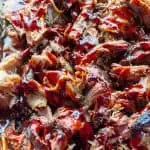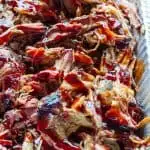Pulled pork is a classic dish that never fails to impress a crowd! The smoky, tender, and juicy meat is a result of slow cooking over low heat, allowing the flavors to develop and the meat to become irresistibly succulent. One of the best ways to achieve this perfection is by using a pellet grill.
In this comprehensive guide, we will walk you through the step-by-step process of making delicious pulled pork using a pellet smoker.
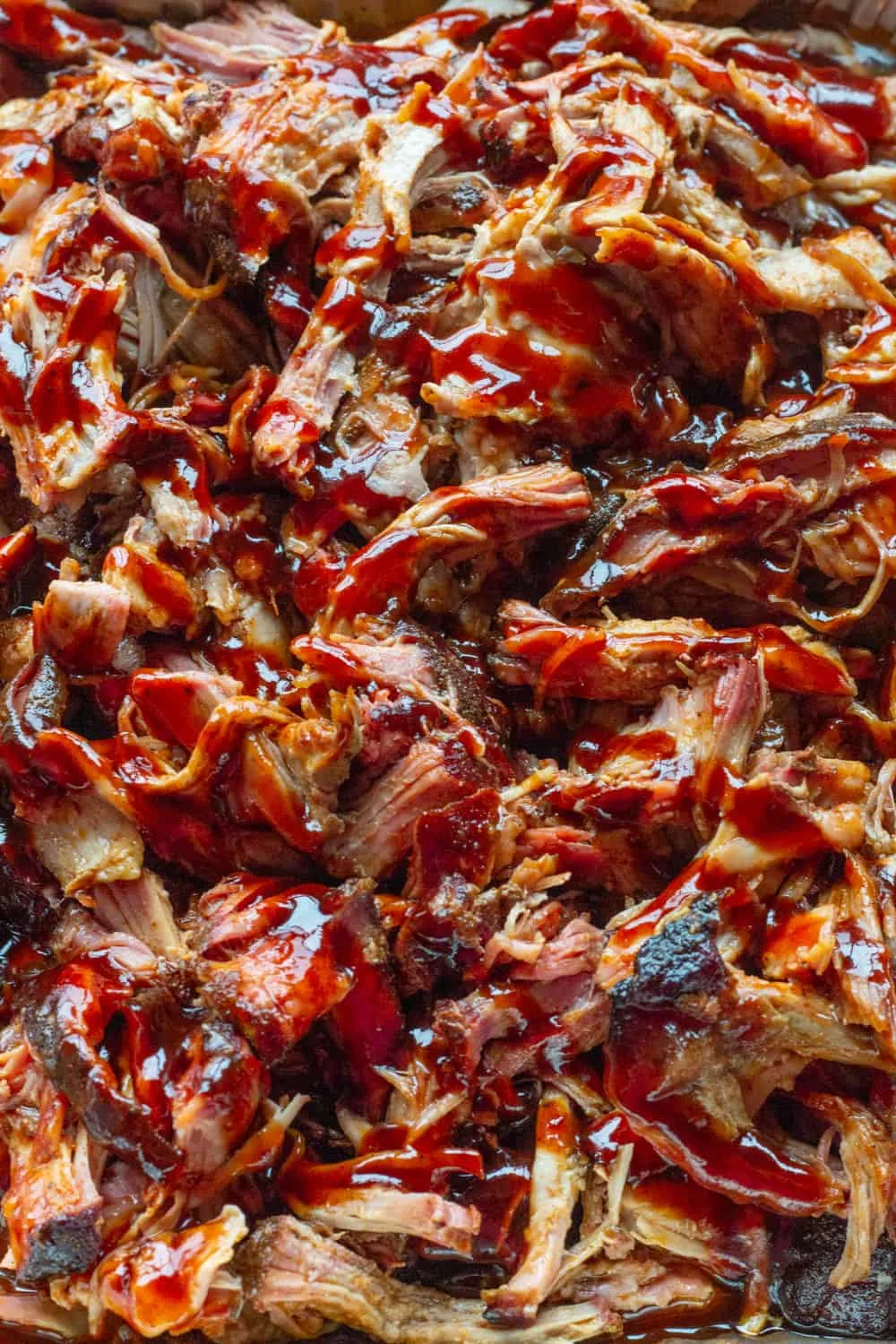
From selecting the right cut of meat to mastering this barbecue technique, you’ll soon be able to savor the rich flavors and tender texture of your very own homemade pulled pork.
Table of Contents
- I. Choosing the Perfect Cut of Meat:
- II. Preparing the Meat:
- III. Preparing the Pellet Grill For The Perfect Pulled Pork:
- V. Shredding and Serving:
- How to Reheat Pulled Pork
I. Choosing the Perfect Cut of Meat:
For Pulled Pork you have 2 choices: Pork Butt (Boston Butt) and Pork Shoulder.
Despite their names, both come from the shoulder of the pig. The butt is higher up on the animal, and the pork shoulder is slightly lower down continuing to the front hooves. The term “butt” originated from the way the pork shoulder used to be stored or transported in barrels, known as “butts.”
Both cuts are well-suited for slow cooking methods like smoking barbecue due to their high-fat content and connective tissues. Both are tough cuts of meat, but when cooked low and slow, the fat and connective tissues break down, resulting in tender and flavorful meat that is ideal for shredding, making it perfect for pulled pork.
I prefer pork butt because it contains more fat which seeps into the meat making it more tender and flavorful, however, I wouldn’t hesitate to use pork shoulder if the butt wasn’t available. This cut offers a good balance of marbling, fat content, and connective tissue that break down during the long cooking process, resulting in tender and flavorful meat that melts in your mouth.
Both cuts can come bone-in or boneless, with the shoulder usually coming bone-in with skin on (aka picnic ham). The pork butt can include the blade bone, which contributes depth of flavor and meatiness to the pork butt recipe.
I use boneless or bone-in pork butt because it’s easy and affordable to buy at the warehouse stores (Costco and Sam’s) in two packs for about $22… Make one now and freeze the other for the next weekend.
A pork butt is usually 5-6 lbs. and takes me 10 hours to smoke. It makes a full half pan of meat and makes about 12- 15 servings.
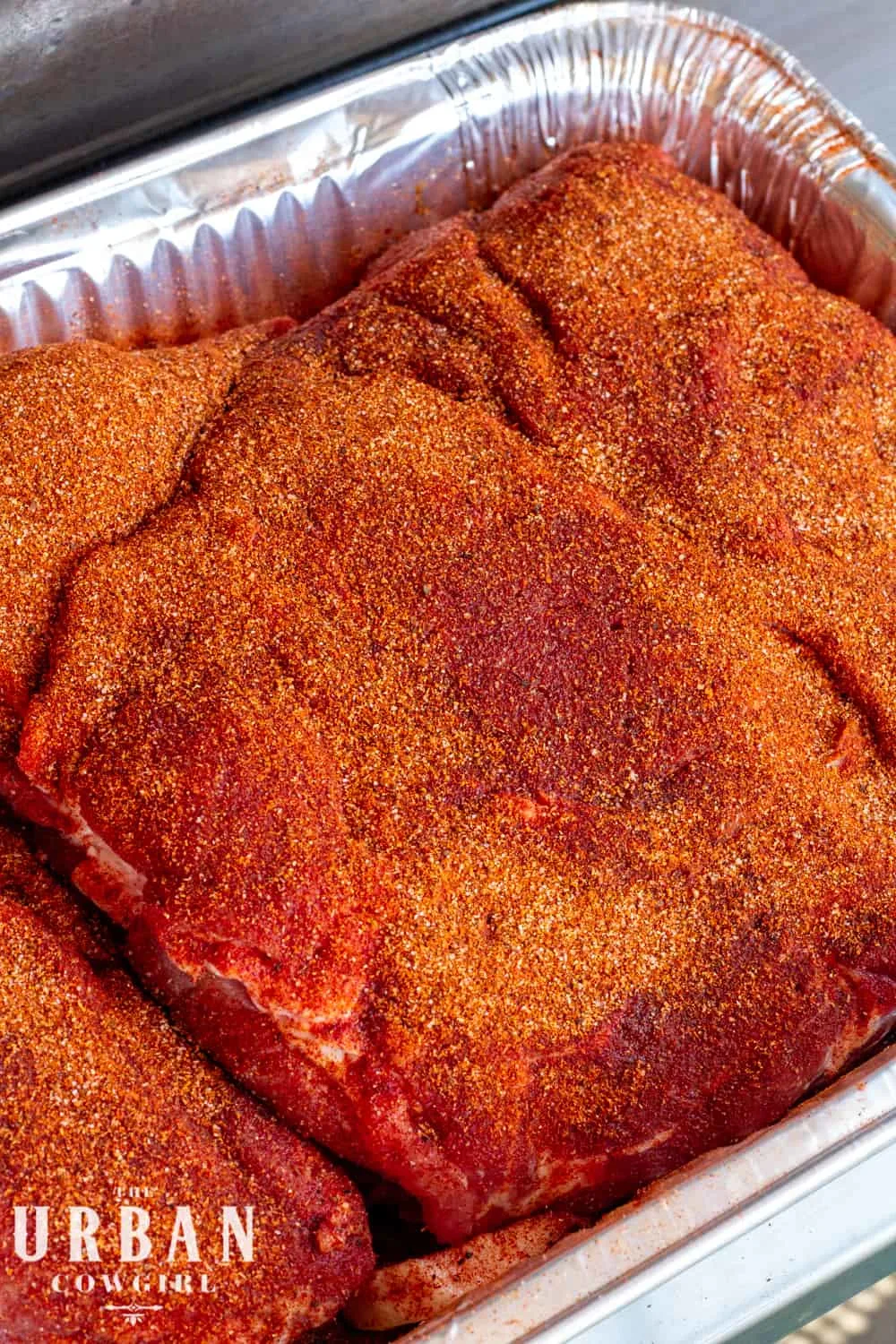
II. Preparing the Meat:
- Trimming: A heavy trim is not required on pork butt as you want the fat cap in place to melt into the meat throughout cooking. Pierce the meat all over with a sharp fork to encourage fat to drip deep inside the pork roast. Some people choose to score the fat cap (dragging a knife diagonally across the fat to create a diamond pattern) but this is unnecessary and only is done for looks. Since the meat will be immediately pulled in order to serve, scoring the fat cap is optional.
- Dry Rub: Generously season the pork shoulder with a dry pork rub of your choice, ensuring all sides are coated evenly. Common ingredients for a pork dry rub include salt, black pepper, paprika, garlic powder, onion powder, and brown sugar. Many people choose to slather the pork in yellow mustard to create a binder for the barbecue rub to adhere to, and this is again optional and up to the pitmaster.
- Resting: Allow the seasoned meat to marinate with the rub for at least 4 hours in the refrigerator, allowing the flavors to penetrate the meat. Many pitmasters wrap their pork in plastic wrap and let it marinate overnight, refrigerated, before smoking. At the very least rest 30 minutes, at room temperature.
- Preparing the Pork Mop Sauce: A mop solution of apple cider vinegar, a dash of salt and sugar, and pork barbecue rub spices should be heated on the stove to help dissolve the salt into the vinegar and bloom the spices. This liquid is then cooled and used through the smoking process to mop both sides of the pork.
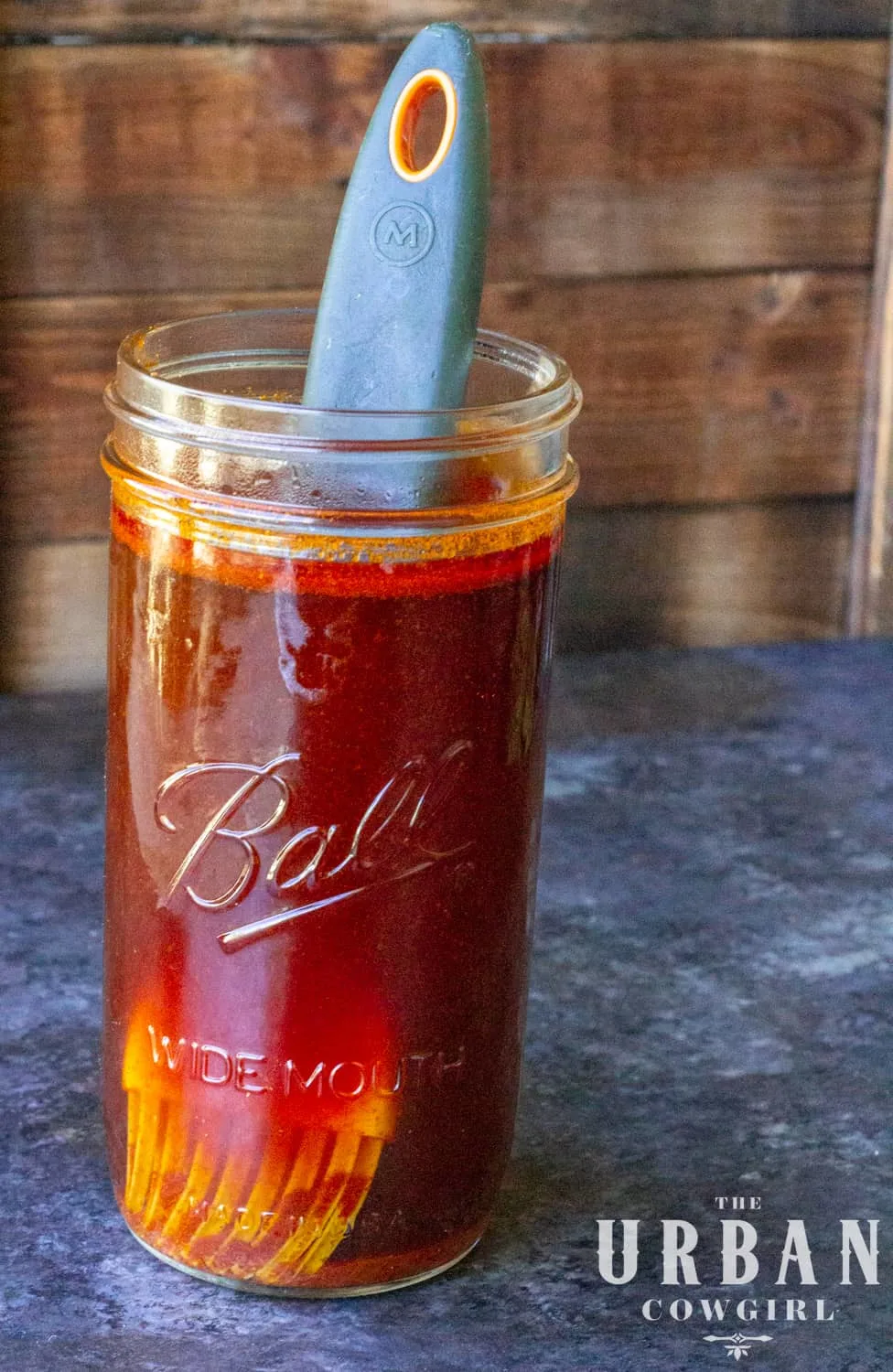
Note: A spray bottle of apple cider vinegar can also be used, but no spices can be added to the fluid or it will clog the nozzle. Some choose to use apple juice or Dr Pepper, but a vinegar mop balances the fattiness of the pork, as well as the sweet bbq sauce we will pair it with, so I much prefer a vinegar mop.
III. Preparing the Pellet Grill For The Perfect Pulled Pork:
- Clean and Preheat: Clean the grill grates thoroughly and remove any leftover ash from previous cooks. Preheat the pellet grill to a temperature of 225°F (107°C), using a pellet smoker ensures the temperature remains stable throughout the cooking process.
- Wood Pellet Selection: Choose wood pellets that complement the flavor of pork, such as hickory, apple, or cherry. Fill the hopper with your chosen pellets.
- Determine how long the cook will last (10 hours for this recipe) and check to make sure you have enough pellets to last the full duration of the cook, (as well as about 20% more pellets just in case). Every brand of pellets is different and you will likely find that you prefer certain brands and blends over others.
All pellets will burn at about 1 pound per hour. One bag of pellets is 20 pounds, so 1 bag should be sufficient.
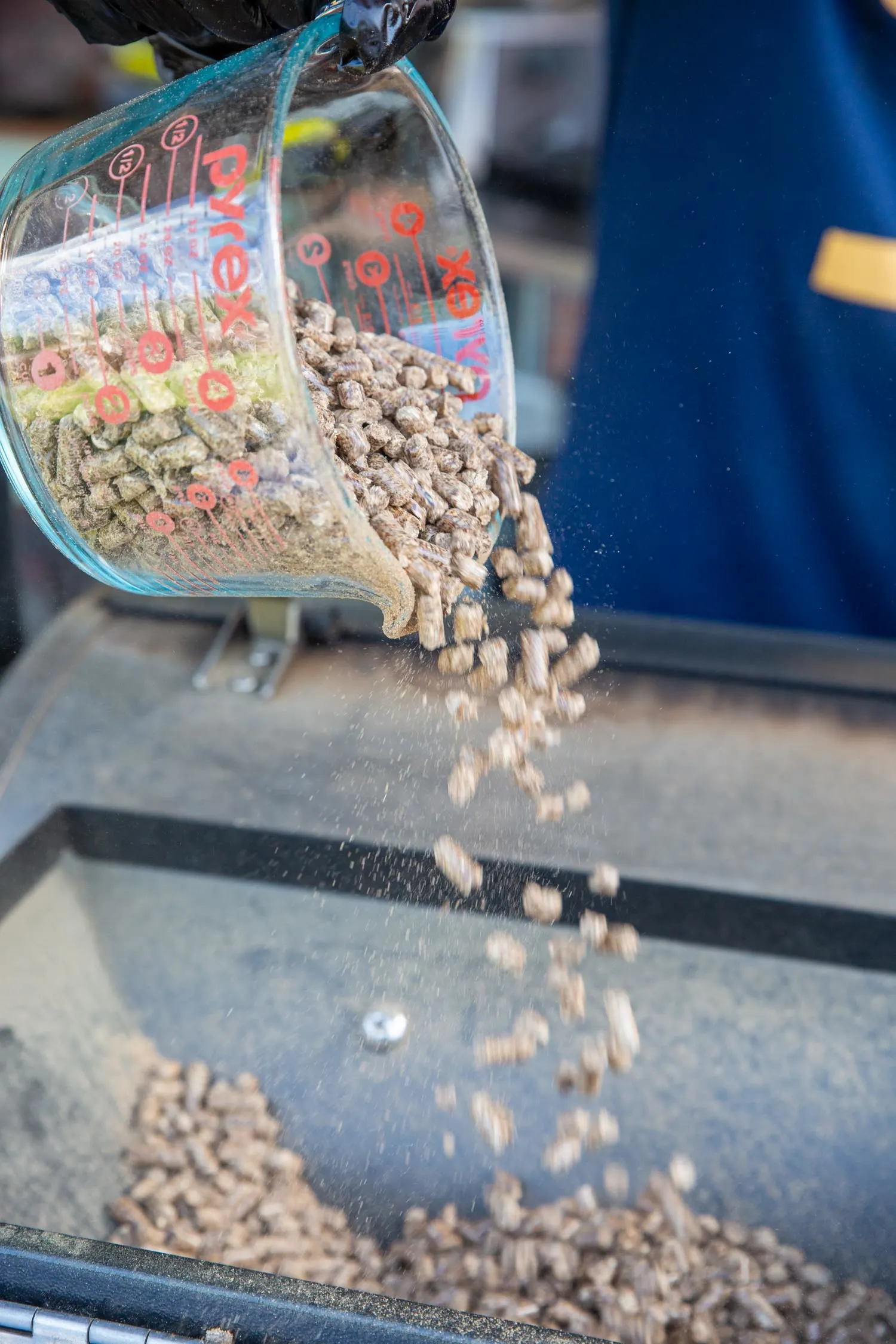
What Wood Pellets are Best With Pulled Pork?
When it comes to selecting wood pellets for making pulled pork, there are several popular options that can enhance the flavor profile of the meat. Here are some commonly used wood pellets for smoking pork:
- Hickory: Hickory wood pellets provide a robust, smoky flavor that pairs exceptionally well with pork. The strong aroma and rich taste of hickory complement the natural sweetness of the meat, resulting in a classic and traditional barbecue flavor.
- Apple: Apple wood pellets offer a slightly sweet and fruity flavor that adds a touch of mild smoke to the pork. This versatile wood imparts a delicate and pleasant taste, making it a popular choice for pulled pork, especially for those who prefer a lighter smokiness.
- Cherry: Cherry wood pellets provide a subtly sweet and fruity smoke that gives the pork a hint of tartness. The mild flavor of cherry wood adds a unique and pleasant taste to the meat, creating a delicious balance of smokiness and sweetness.
- Maple: Maple wood pellets offer a milder smoke flavor with a touch of sweetness. This wood provides a more delicate smoke profile that complements the natural flavors of pork without overpowering them. It adds a subtle and slightly sweet note to the pulled pork.
- Pecan: Pecan wood pellets impart a nutty and slightly sweet smoke flavor to the meat. It is a popular choice for pork, as it enhances the natural flavors and adds a unique and enjoyable smoky taste without being overpowering.
- Mesquite: Mesquite wood pellets offer a bold and robust smoke flavor. While mesquite is more commonly associated with beef, it can still be used with pork to create a stronger and uniquely Texas flavor. However, it’s essential to use mesquite sparingly to avoid overwhelming the pork’s flavor.
Remember, the choice of wood pellets ultimately comes down to personal preference. Some pitmasters like to experiment with blends or combinations of different wood pellets to create their own unique flavor profiles.
Regardless of the wood pellets you choose, check the flow rate of your pellet grill to ensure you’re settings are creating lots of good smoke for great flavor in any pork recipe.
IV. Smoking and Cooking the Pork Shoulder:
This is where the magic happens! Follow these steps to smoke and cook the pork shoulder to perfection. (This process takes about 10 hours cook time total.)
- Placement: Place the seasoned pork shoulder directly on the grill grates, fat side up, allowing ample space for the smoke to circulate. Probe the pork with a meat thermometer (This is what we use) during this time.
- Smoking: Smoke the pork shoulder at 225°F for the first few hours to infuse it with rich smoky flavors while monitoring the internal temperature of the pork roast using a thermometer probe. After an hour and a half, mop with the mop sauce every 30-45 minutes.
- Wrapping: When the pork reaches 160-170°F internal temperature, wrap the pork in pink butcher paper or aluminum foil to help retain moisture. You can also place the pork in a disposable aluminum pan and cover it with foil.
- Continued Cooking: Return the wrapped pork shoulder to the pellet grill and continue cooking until the internal temperature reaches around 203-206 °F (95-98°C). Smoking to 206 makes the best smoked pork that is easy to shred.
- Resting: Once the desired temperature is reached, remove from the barbecue smoker and let the meat rest, still wrapped, for about an hour. This allows the juices to redistribute and ensures maximum tenderness.
How to Probe the Pork Butt
Your pellet smoker likely comes with 1-2 probes which are inserted into the thickest part of the butt and give you real-time feedback of the current temperature of the pork shoulder roast. You can place these in the pork butt at the beginning of the cook, or after about 4 hours.
When you insert the probe it is absolutely essential to avoid the probe touching a bone if you selected a bone in cut. If the probe touches a bone in any type of barbecue, you will receive a temperature reading of the bone which can be 15-20 degrees hotter than the surrounding meat.
Insert the probe into the thickest part of the pork roast, while avoiding the bone. If your pellet grill did not come with a probe or you’ve misplaced it, I recommend the Meater Wireless Probe, which I use for just about everything I smoke or grill these days.
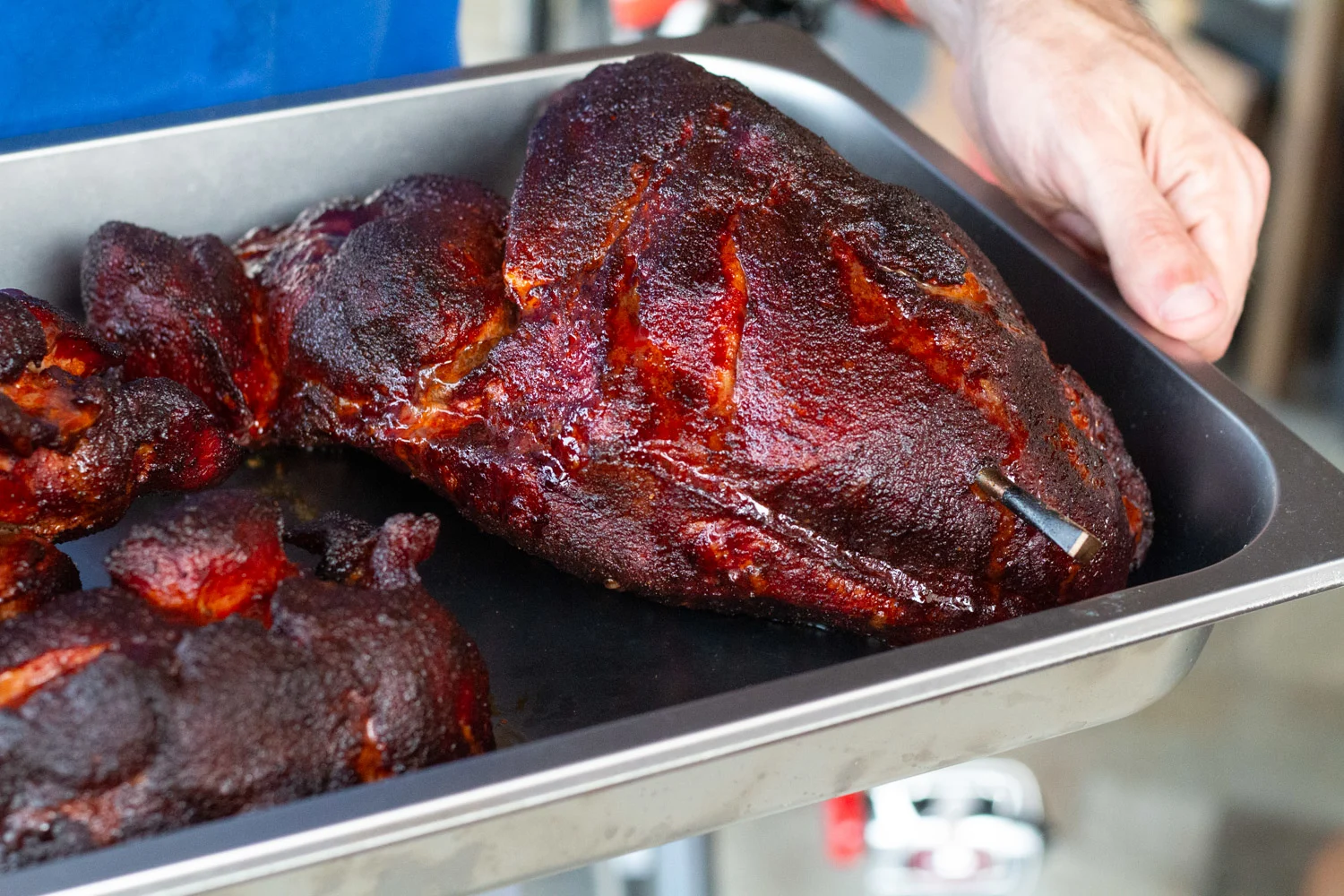
When Should I Wrap the Pork Butt?
Most people who wrap their pork butts do so at 160-170 degrees. I highly recommend wrapping your pork butt when smoking on a pellet grill because there is heat coming from underneath. It may be minimal heat, but it’s certainly more than a traditional stick smoker, which just deals with smoky air circulating.
I place my pork butt in half pans, pour a bit of the vinegar mop sauce into the pan, and cover tightly with foil. The pork butt will finish in this moist environment, seeping juices that make a flavorful au jus.
It mixes well with the vinegar mop sauce and creates the foundation for an unbelievable barbecue sauce. Also, using this method, the bark which we have worked so hard to achieve mostly stays intact, whereas other methods I have used (such as wrapping in butcher paper) turn the bark to mush. After wrapping in the pan, there is no need to mop anymore.
What Temperature Should I Cook Pulled Pork to On the Pellet Smoker?
I cook to 206 degrees, unplug the probe, but leave it inserted in the meat, and place it in a room temperature place in the kitchen to rest, like a countertop lined with a kitchen towel.
Depending on how quickly you want to pull and eat the pulled pork will determine if you remove the foil…if you are waiting on guests, it will stay significantly hot left in the foil tent for hours. If you want to pull it sooner, remove the foil and continue to let it rest for 1 hour before pulling.
To pull the pork, begin by removing the probe. You will need to use double-gloved hands or pulled pork claws to pull the pork if it is still relatively hot. Pull the pork into manageable chunks and then break each chunk up into tender 2-inch long ribbons.
For the sauce, I use the liquid which has accumulated in the bottom of the pan which is a combination of natural juices and the bit of the vinegar mop we poured in before we tented with foil. This is a great time to drizzle on barbecue sauce and let it combine with the juices present to make an earthshakingly good sauce!!
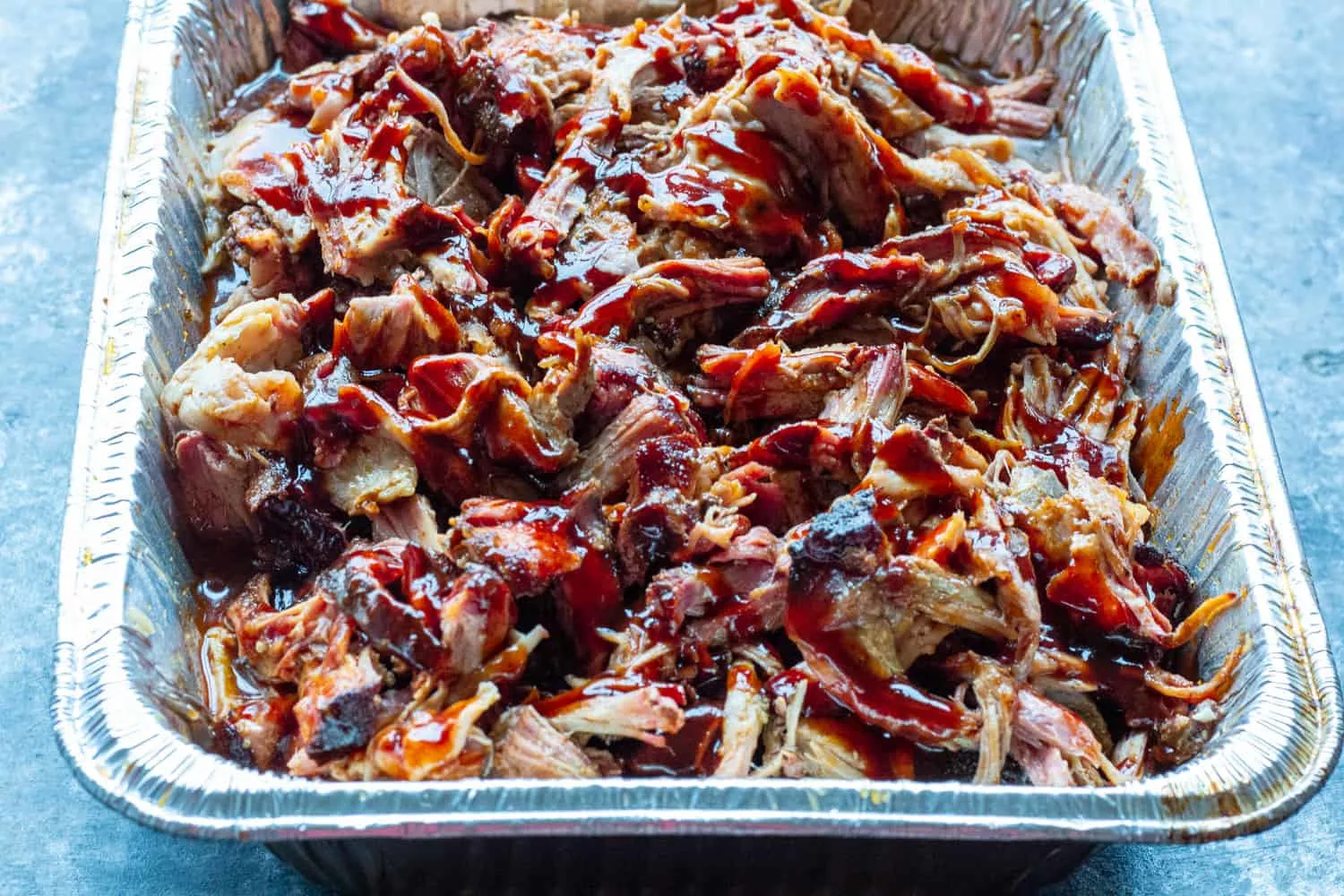
V. Shredding and Serving:
The final step is to transform your beautifully cooked pork shoulder into the ultimate pulled pork:
- Shredding: You will need to use double-gloved hands or pulled pork claws to pull the pork if it is still relatively hot. Pull the pork into manageable chunks and then break each chunk up into tender 2-inch long ribbons. Gently pull the meat apart, discarding any excess fat and bones. The pork should easily separate into tender strands.
- Sauce and Seasoning: Toss the shredded meat with your favorite bbq sauce to enhance the flavor. Feel free to experiment with different types of sauces, from tangy and sweet to spicy and smoky.
- Serving: Serve the pulled pork on fresh buns or rolls, accompanied by coleslaw, pickles, or any other desired toppings. The result will be a delectable, flavorful, and tender pulled pork sandwich.
How to Reheat Pulled Pork
Smoking a 6-8 pound pork butt for your family will likely produce more meat than you can eat in one setting. For this reason, it’s helpful to know how to reheat it.
My favorite method is placing the half pan, covered in foil, into a 300-degree oven for 20-30 minutes. The juices accumulated during the cook should be enough moisture to reheat, but adding 1/4 c. of barbecue sauce or beef broth is also fine.
By following these steps, you can create pulled pork that rivals the best barbecue joints. The pellet grill’s steady heat and natural wood smoke infuse the meat with incredible flavors, while the slow smoking process ensures the pork shoulder becomes fall-apart tender. Remember to be patient and allow sufficient time for the cooking process. The end result will be worth every minute of anticipation!
Whether you’re hosting a backyard barbecue or simply craving a comforting meal, this guide has provided you with the knowledge and confidence to master the art of making pulled pork using a pellet grill. Get ready to impress your family and friends with your culinary prowess and savor the unrivaled deliciousness of your homemade pulled pork!
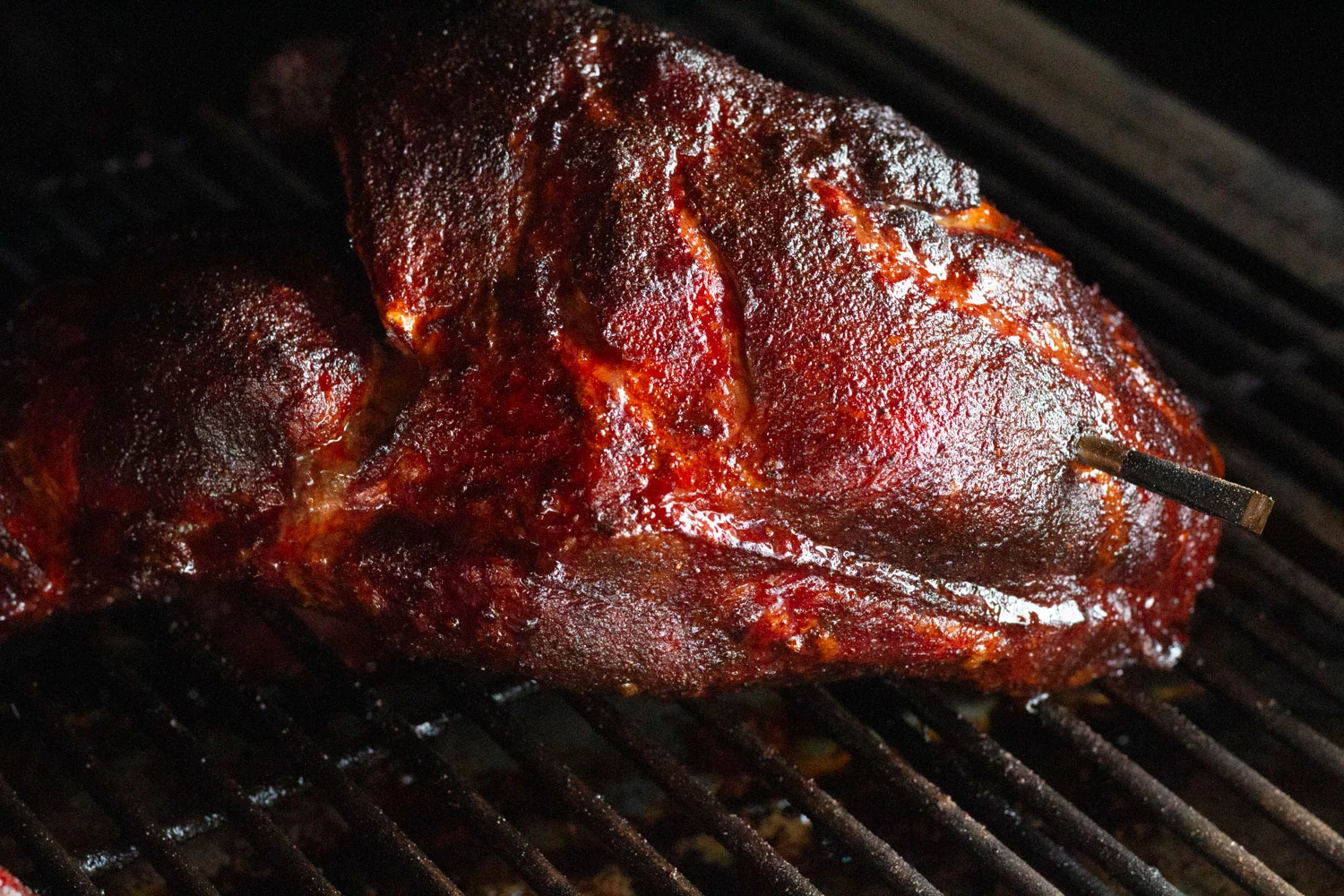
Easy Links to Items/Tools Used in This Recipe:
Metal Seasoning Shaker with Handle (holes large enough for my rub)
Thermo Pro Barbecue Probe (competition grade)
Pulled Pork Favorite Sides and Appetizer Recipes:
Houston Rodeo Blue Ribbon Potato Salad
Smoked Queso (I made mine on my pellet grill)
Brisket Queso (Can be done with leftover pulled pork as well!)
Have questions? Need help? Have an addition or a suggestion to a recipe? Drop me a comment below!
If you make this recipe, I would LOVE to see it!
Tag me on Instagram @UrbanCowgirl and use #UrbanCowgirl to be featured. 🙂
Follow us on Social Media using the links below!!
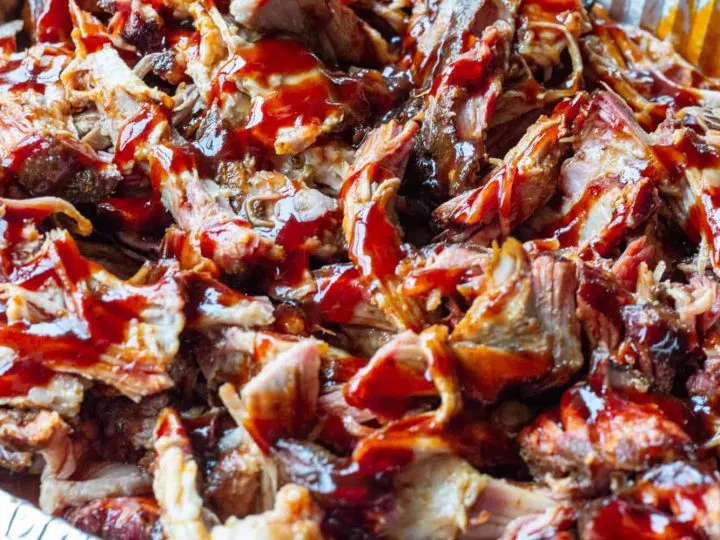
Pellet Grill Pulled Pork Recipe
Get ready to impress your family and friends with your culinary prowess and savor the unrivaled deliciousness of your homemade pulled pork on the pellet smoker!
Ingredients
- 1 Pork Butt (usually 5-6 lbs.)
Homemade Pork Rub:
- 1/2 c. fresh paprika
- 1/4 c. kosher salt
- 1/4 c. sugar
- 1/4 c. cumin (ground)
- 1/4 c. Texas chili powder
- 1/4 c. granulated garlic
- 1 T. dry ground ginger
- 2 T. dry mustard powder
- 2 T. black pepper
- 2 T. cayenne pepper
Vinegar Mop Sauce:
- 1-quart apple cider vinegar
- 1 c. water
- 2 T. sugar
- 2 T. Texas chili powder
- 1 T cayenne
- 2 T kosher salt
- 3 T oil
Other Items
- 1 cup Barbecue Sauce.
- Buns and toppings if you want to make pork sandwiches (coleslaw, pickles, etc.)
Instructions
To Prep:
Open the pork butt from the package and place it into an aluminum half pan, draining the juices well. Pat dry with paper towels. Using a sharp fork, puncture the meat of the pork butt on all sides.
Mix all of the rub ingredients in a Tupperware container, place the lid on, and shake well. Pour some rub into the metal shaker, replace the lid, and shake well patting the rub into the meat. Avoid "rubbing" it in, that doesn't work. Do this on all sides of the pork, wait 5 minutes for it to absorb, then shake and pat again.
Cover the meat with foil and refrigerate for 4 hours, or overnight for maximum flavor.
For the Mop Sauce:
Place all of the ingredients in a small saucepan and bring to a boil. Stir well. Set aside to cool. You will mop the meat with a barbecue mop throughout cooking to keep it moist and add flavor to the bark.
To Smoke The Best Pulled Pork:
Heat the pellet grill to 225 degrees. Load the hopper with sufficient pellets and check the feed rate to make sure you are getting a good steady flow of clean smoke.
Probe the pork butt using the probe from your pellet grill or a standard barbecue probe. Place it on the smoker, sprinkle on a little extra rub, and close the chamber.
Smoke the pork roast for 1.5 hours and then begin mopping about every 30- 45 minutes to keep the pork moist.
When the pork reaches between 160-170 degrees, place the butt into a new aluminum half pan. Sprinkle with rub, and pour about 1/2 c. of the mop sauce into the bottom of the pan to provide moisture. Tent with foil and place back into the pellet grill.
Smoke until the pork reaches 206 degrees. Remove from the pellet grill to a room temperature place away from dogs, friends, and nosy neighbors to rest for at least 1 hour.
Leaving the foil on top will keep the meat hot for hours if you are waiting for guests. Vent the foil a little bit to let steam escape if you're ready to rest the pulled pork, pull and serve.
When you are ready to pull the meat, do so double-gloved with nitrile gloves or with pork claws as it is still very hot. Sauce the meat with barbecue sauce and serve!
Notes
This recipe will make enough rub and mop sauce for 2 pork butts at one time if you want to make 2.
Nutrition Information:
Yield:
15Serving Size:
1Amount Per Serving: Calories: 194Total Fat: 6gSaturated Fat: 1gTrans Fat: 0gUnsaturated Fat: 5gCholesterol: 12mgSodium: 1964mgCarbohydrates: 28gFiber: 4gSugar: 16gProtein: 6g
This nutritional information is provided as a courtesy as an estimate only. Consult with a dietician for precise estimates. This website makes no claims that the nutritional values listed are accurate.

